60TH ANNIVERSARY OF A HISTORIC ICON AND ADVERTISING CAMPAIGN
How Smokey Bear Battles Wildfires in the Garden State

Hoag Levins ...| ...Sept. 27, 2004

CAMDEN, N.J. -- Although most people tend to associate Smokey Bear and wildfires with conflagrations raging across western states, both have played a major role in the history and current daily life of New Jersey and one -- the bear
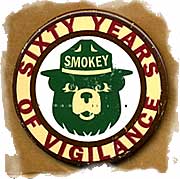
|
| Photo: Hoag Levins |
2004 marks the 60th year that Smokey Bear has served as a fire prevention symbol.
|
-- is celebrating his 60th anniversary this year.
Historic ad campaign
The "Only You Can Prevent Forest Fires" promotion conducted by the U.S. Forest Service, the National Association of State Foresters and the Ad Council, is the world's longest-running public service advertising campaign. And, to the surprise of many, Smokey Bear has been very active in Camden County and the rest of New Jersey during all those years.
Originally designed as part of the domestic defense system during World War II, Smokey Bear evolved into one of America's most enduring cultural symbols. During its first few decades, the image of Smokey was so important to the U.S. government that G-men of J. Edgar Hoover's FBI were assigned to protect it. Today the bear is a major historical icon for firefighting, advertising and tourism industries. He is also a symbol that takes on heightened significance every year during October, national Fire Prevention Month.
Despite his cutesy charm and association with giddy young children, the cartoon character Smokey Bear represents a deadly serious business in New Jersey. That business involves large amounts of government funds, thousands of state workers, frequent injury, occasional deaths and destruction, at times, on a massive scale.
Although viewed as a crowded metropolitan landscape where
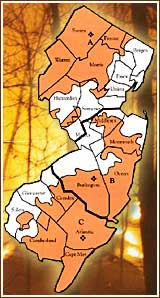
|
| Map: NJ Forest Fire Service |
It amazes many to learn that so much of the surface area (shown here in orange) is covered in thick, fire-prone woodlands.
| a gritty turnpike bisects carpets of refineries, strip malls and dense housing developments, about 42% -- or roughly 2 million acres -- of New Jersey's total land surface is actually covered with forests. Every year, more than 1,600 indivdual wildfires break out in those woodlands, according to New Jersey State Chief Fire Warden Maris G. Gabliks. That's an average of more than four fires every day of the year.
"The wildfire potential in New Jersey is very great," said Mr. Gabliks from his Trenton office. "Because of the state's density, nearly every wildfire ultimately threatens somebody's property or life here. The threat is particularly bad throughout the Pine Barrens where we get large wildfires."
Camden County wildfires
In fact, according to the Department of Environmental Protection, one of New Jersey's largest wildfires last year was an April blaze that raged across 275 acres of woodlands in Waterford Township at the Pinelands end of Camden County.
To detect and fight wildfires from the mountainous highlands region in the north to the pine forests of Cape May in the south, the state's Forest Fire Service has 90 full-time employees and about 2,000 on-call part-timers supported by 21 fire towers and a small airforce of helicopters and fixed wing aircraft.
Mr. Gabliks noted that more than 90% of all the wildfires flaring across the state each year are caused by people, rather than natural events like lightning, which is why educational programs aimed at adults as well as children are so crucial to the overall fire control effort.
Public awareness
"The Smokey Bear symbol and campaign plays a central role for us," said Mr. Gabliks. "Just in terms of public awareness it does the job of keeping the issue on people's minds."
Chris Bethmann, superintendent of Brendan Byrne (formerly Lebanon) State Forest in New Lisbon, deep in the Barrens agreed. He said there are Smokey Bear fire danger rating signs adjacent to all New Jersey state forest entrances and elsewhere around the state in forests and parks. "Many people I speak with
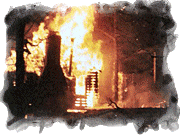
|
| NJ Forest Fire Service |
These dramatic New Jersey Forest Fire Service photos show a typical wildfire devastating a wooded residential area in Mahwah, Bergen County.
| actually read the signs, and notice when the fire danger is particularly high,'he said. "It's very common to see visitors having their picture taken next to the Smokey sign in front of my office."
"It's always tough to know how effective your message is in preventing something from happening," said Mr. Bethmann, "but if awareness is any measure, it's easy to see that Smokey is a genuine success."
Arrange a Smokey visit
Four state Forest Fire Service offices around the state regularly provide Smokey Bear educational fire prevention programs for schools -- including visits by the great bear himself. Contact information can be found on the the NJ DEP's SEEDS Web site.
The agency also regularly takes Smokey Bear to shopping malls, open houses and other public events.
New Jersey began celebrating Smokey Bear's 60th anniversary early in the year and in June, in the largest state event to date, Smokey arrived by helicopter for a party at Wells Mills Park in Waretown. It is the largest facility in Ocean County's 900-acre system of Pine Barrens parks.
Earlier this month, the string of national events celebrating the Smokey Bear anniversary reached a crescendo of sorts as the bear was feted in New York's Grand Central Station at the south end of the Times Square district, the heart of the national advertising industry that spawned and has supported the ad campaign for the last six decades.
In New Jersey, the local Smokey anniversary festivities continue through October, which is Fire Prevention Month.
A symbol born in wartime
Sixty years ago, the idea for Smokey Bear was born out of military concern in World War II, evolving from a civil defense mobilization response to the possibility of "fire storm" attacks on the U.S. homeland by the Japanese. Fire storm warfare was an old military concept given new potential by the era's long-distance aircraft and high-tech naval systems. Those military tools provided a means for efficiently spreading fire in an unprecedented manner across large geographic regions. It was a concept the Allied Forces would later use to horrific effect on the
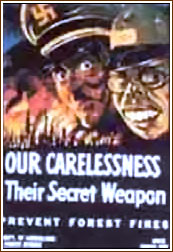
|
| Ad Council |
The Smokey Bear fire prevention campaign evolved out of civil defense campaigns designed to deal with potential 'fire storm' attacks during World War II. Forest fire prevention posters from the era are classic wartime propaganda visuals.
| German city of Dresden as well as Japan's capital, Tokyo.
In 1941 the Western regions of the U.S. were particularly vulnerable to fire war because of the vast forests that surrounded their inhabited areas, along with regular high wind conditions and frequent dry seasons. The U.S. government took the fire storm attack threat seriously when, just weeks after Pearl Harbor, a lone Japanese submarine surfaced to shell an oil refinery near Santa Barbara on the southern coast of California.
Advertising Council
That attack occurred at nearly the same moment the chiefs from the largest advertising agencies across the country were opening the Washington headquarters of a new organization -- the Advertising Council. The Council was designed to apply the power of modern marketing communications to the task of mobilizing national morale and manpower in wartime.
The national Forest Service itself started the first wartime public awareness program focused on fire-fighting. One early advertising tagline it used was "Careless matches aid the Axis."
By 1944, working as part of the Advertising Council's effort, ad agency Foote Cone & Belding of New York had crafted the concept of Smokey Bear into an advertising campaign with the"Only You Can Prevent Forest Fires" slogan.
From its inception, the Smokey Bear icon was jealously and diligently guarded as a federal government treasure. In 1953 Congress passed a law that still makes it a federal crime to "knowingly and for profit manufacture, reproduce or use the character of 'Smokey Bear'" without a license.
Smokey's FBI file
At the same time, Smokey Bear became the subject of an FBI file, which the author has obtained through a Freedom of Information Act request.
That FOIA document indicates that in the 1950s, the Smokey Bear ad image was of such significance to federal authorities that J. Edgar Hoover's
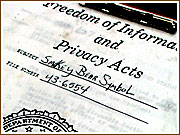
|
| Photo: Hoag Levins |
In 1953 the FBI was assigned the task of protecting the government-owned Smokey Bear brand image. The Bureau's Smokey Bear file was obtained through the Freedom of Information Act. Click to see larger FBI file images.
| FBI G-men were officially charged with protecting its integrity.
A 1953 internal memo sent to special agents in FBI bureaus across the country informed them that their duties now included responding to incidents of "unauthorized use of Smokey Bear."
The records show that one of the first suspects targeted for FBI scrutiny was a 1953 quarter-page ad in the San Antonio Light newspaper. Placed by Joskey's of Texas department store, it offered a 15-inch stuffed teddy bear wearing a felt Smokey Bear ranger hat and holding a long-handled shovel.
A Dec. 27, 1954, letter from the U.S. attorney for the Northern District of Illinois praised the FBI's Chicago office for its "prompt, severe and unalterably fair" pursuit of another Smokey Bear investigation. It notes that the Chicago unit's swift actions "constitute an excellent guide for the handling of any future violations of this type."
In providing the file, modern-day FBI FOIA officials have dutifully blacked out the names of the FBI agents involved in these Smokey Bear capers of the 1950s.
Smokey licensing rights today
Today, Lisboa Inc. of Washington, D.C., is the official licensing agent retained by the Forest Service for all Smokey-related brand licensing. Its current online directory lists more than 50 authorized vendors making a wide array of authorized Smokey Bear products from coloring books and bolo ties to lunch boxes and temporary tattoos along with all the de rigueur souvenir shop hats, t-shirts and posters. The full list can be seen at SmokeyBearLicensing.com.
According to Lisboa's Smokey Bear licensing manager, Max Farrow, the agency takes in about $100,000 in licensing fees a year, of which it keeps about 30%. The balance helps fund the Forest Service's Forest Fire Prevention Program.
| 










